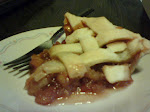Substitute apple cider vinegar when a recipe calls for an acid, such as lemon. Whisk together apple cider vinegar with crushed fresh garlic, fresh-ground black pepper, olive oil  and a pinch of salt and cumin. Pour over steamed vegetables such as asparagus, broccoli or zucchini. * Marinades do more than give meat flavor; marinating meat also makes it more tender. Instead of using wine, or other types of vinegar, use apple cider instead. * Apple cider vinegar makes a great sauce when tangy is what you’re looking for. An apple cider vinegar sauce, or glaze, is also great over ham. Redu
and a pinch of salt and cumin. Pour over steamed vegetables such as asparagus, broccoli or zucchini. * Marinades do more than give meat flavor; marinating meat also makes it more tender. Instead of using wine, or other types of vinegar, use apple cider instead. * Apple cider vinegar makes a great sauce when tangy is what you’re looking for. An apple cider vinegar sauce, or glaze, is also great over ham. Redu ce apple cider vinegar, garlic, brown sugar, paprika, black pepper and thyme until it is the consistency of gravy. * Recently, there has been lots of articles about the health benefits of drinking apple cider vinegar. Apple cider vinegar is highly acidic. The main ingredient of apple cider vinegar is acetic acid. As the name suggests, it's quite harsh. Apple cider vinegar should always be diluted with water or juice before swallowed. Pure apple cider vinegar could damage the tooth enamel and the tissues in your throat and mouth. So maybe Apple Cider Vinegar is best used in cooking. ~ Chef ~
ce apple cider vinegar, garlic, brown sugar, paprika, black pepper and thyme until it is the consistency of gravy. * Recently, there has been lots of articles about the health benefits of drinking apple cider vinegar. Apple cider vinegar is highly acidic. The main ingredient of apple cider vinegar is acetic acid. As the name suggests, it's quite harsh. Apple cider vinegar should always be diluted with water or juice before swallowed. Pure apple cider vinegar could damage the tooth enamel and the tissues in your throat and mouth. So maybe Apple Cider Vinegar is best used in cooking. ~ Chef ~
 and a pinch of salt and cumin. Pour over steamed vegetables such as asparagus, broccoli or zucchini. * Marinades do more than give meat flavor; marinating meat also makes it more tender. Instead of using wine, or other types of vinegar, use apple cider instead. * Apple cider vinegar makes a great sauce when tangy is what you’re looking for. An apple cider vinegar sauce, or glaze, is also great over ham. Redu
and a pinch of salt and cumin. Pour over steamed vegetables such as asparagus, broccoli or zucchini. * Marinades do more than give meat flavor; marinating meat also makes it more tender. Instead of using wine, or other types of vinegar, use apple cider instead. * Apple cider vinegar makes a great sauce when tangy is what you’re looking for. An apple cider vinegar sauce, or glaze, is also great over ham. Redu ce apple cider vinegar, garlic, brown sugar, paprika, black pepper and thyme until it is the consistency of gravy. * Recently, there has been lots of articles about the health benefits of drinking apple cider vinegar. Apple cider vinegar is highly acidic. The main ingredient of apple cider vinegar is acetic acid. As the name suggests, it's quite harsh. Apple cider vinegar should always be diluted with water or juice before swallowed. Pure apple cider vinegar could damage the tooth enamel and the tissues in your throat and mouth. So maybe Apple Cider Vinegar is best used in cooking. ~ Chef ~
ce apple cider vinegar, garlic, brown sugar, paprika, black pepper and thyme until it is the consistency of gravy. * Recently, there has been lots of articles about the health benefits of drinking apple cider vinegar. Apple cider vinegar is highly acidic. The main ingredient of apple cider vinegar is acetic acid. As the name suggests, it's quite harsh. Apple cider vinegar should always be diluted with water or juice before swallowed. Pure apple cider vinegar could damage the tooth enamel and the tissues in your throat and mouth. So maybe Apple Cider Vinegar is best used in cooking. ~ Chef ~








































 Vinegar has many uses, which we will discuss tomorrow.
Vinegar has many uses, which we will discuss tomorrow.







































 Mustard seeds (top left) may be ground (top right) to make different kinds of mustard. The other four mustards pictured are a simple table mustard with tumeric coloring (center left), a Bavarian sweet mustard (center right), a Dijon mustard (lower left), and a coarse French mustard made mainly from black mustard seeds (lower right). ~ So you see that simple container of mustard is more complicated than you might think. ~ Chef ~
Mustard seeds (top left) may be ground (top right) to make different kinds of mustard. The other four mustards pictured are a simple table mustard with tumeric coloring (center left), a Bavarian sweet mustard (center right), a Dijon mustard (lower left), and a coarse French mustard made mainly from black mustard seeds (lower right). ~ So you see that simple container of mustard is more complicated than you might think. ~ Chef ~

